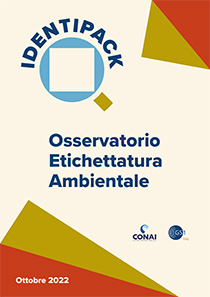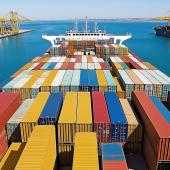Claim green on label under observation
Mandatory by law from January 1, 2023, information about the identification of the material of which a package is made and indications for separate collection. From the collaboration between CONAI and GS1 Italy comes IdentiPack, the first national Observatory on the environmental labeling of packaging. Objective: to create a common language to share information related to the sustainability of products and processes by companies along the entire supply chain.
IdentiPack is the result of a collaboration between CONAI - the National Packaging Consortium that in Italy is the guarantor of the achievement of European recycling targets - and GS1 Italy, one of the GS1 nonprofit organizations active in 116 countries around the world that promote the use of GS1 standards, the most widely used standards for business-to-business communication. The first edition of the Observatory refers to 128 thousand products digitized by GS1 Italy’s Immagino service as of Dec. 31, 2021 combined with NielsenIQ sales data. The report can be viewed at osservatorioidentipack.it
IdentiPack will constantly monitor the presence of environmental information on the labels of packaging released for consumption in Italy and every six months will return a detailed analysis of products on the market, taking a snapshot of the situation regarding those available on the shelf and then actually purchased by consumers, segmenting them according to the departments they belong to.
Using the GS1 GTIN barcode standard to identify products, the Observatory’s analytical work cross-references the environmental information reported on consumer packaging labels, digitized by GS1 Italy’s Immagino service (in this first edition, as many as 128 thousand), with NielsenIQ elaborations on sales in Italian hypermarkets and supermarkets (retail measurement service).
It will thus be possible to have up-to-date data on how many products present on the label the environmental information that will be compulsory from next January-identification of the packaging composition material and indications for separate collection-and how many carry additional information, such as voluntary marks linked to the packaging’s sustainability characteristics, tips on how to do quality separate collection, or digital systems such as QR codes and the GS1 Digital Link to refer to web pages that show the environmental information on the packaging.
Digital label, new frontier
«This is - as CONAI President Luca Ruini anticipates - a step forward in monitoring the response of Italian companies to the environmental labeling obligation. Indeed, it will allow us to understand how companies are moving and to find out if some sectors are struggling to adapt to the new obligation, as well as to study how the voluntary labeling phenomenon is taking shape and in which sectors. We will also be able to monitor what appears to be a real new frontier, the digital label: finding out how much and how it is being used will be useful for both the packaging industry and the recycling supply chain».
Speaking on the subject, Bruno Aceto, CEO of GS1 Italy, said, «From barcodes to QR codes and the GS1 Digital Link: the common and global language enabled by GS1 standards is experiencing a continuous evolution, which travels hand in hand with that of the FMCG world, where the digital transition is also profoundly transforming drivers and purchasing behaviors». At the heart of this evolution is data, which tells us of consumers who are increasingly aware, attentive to sustainability and seeking information on which to base their consumption choices. «With IdentiPack, which joins the Immagino Observatory and GS1 Italy’s Non Food Observatory, we are continuing our mission of fostering market knowledge, offering companies and the system analysis tools, information and stimuli that are useful for orienting strategic choices toward greater sustainability. What is needed is a common language, that of GS1 standards and GS1 Italy solutions, which allows information related to the sustainability of products and processes to be shared by companies throughout the supply chain, all the way to the end consumer, with whom to open an increasingly effective and transparent channel of communication so that they can make informed and sustainable choices».
The first data: encouraging
Based on the first IdentiPack report, in 2021 on the Italian market, products carrying environmental information related to the pack increased compared to the previous year, thus ahead of the entry into force of the obligation established by European and Italian standards.
On 17,300 shelf labels, there is already identification coding of the material used, in accordance with Decision 129/97/EC. They correspond to 13.5% of total on-shelf references in grocery (+3.2% compared to 2020) and 25.1% of total products sold (+1.8% compared to 2020).
Indications on the type of packaging and proper disposal in separate collection already appear on 46,156 references. We are talking about 36.0% of all grocery products on the shelf monitored in 2021 (+2.2% compared to 2020) and 55.5% of those actually sold (+0.9% compared to 2020).
Not to mention that today, the labels of 4,268 products have at least one indication that environmental information on the product’s contents or packaging can be viewed digitally. A basket that includes 3.3% of shelf references and those sold overall. The number grew by 0.3% when compared to 2020.
Among the commodity sectors analyzed, the refrigeration sector ranks first on the podium for the communication of environmental information of packaging: ice cream and frozen food take the leadership in terms of the incidence of products that carry on the label the identification coding of the material in addition to indications on the type of packaging and on the correct disposal in separate collection. But they also shine for the presence of certifications related to packaging compostability and suggestions for improving recycling at home. Also doing well is food grocery, a sector in which four out of 10 products indicate the material the packaging is made of and the correct way to sort it.
To home care, on the other hand, the palm for use of digital channels that provide additional information-a department pioneering in making QR codes and digital links available to the consumer, which are widespread on its packaging far more than in the rest of grocery.






















